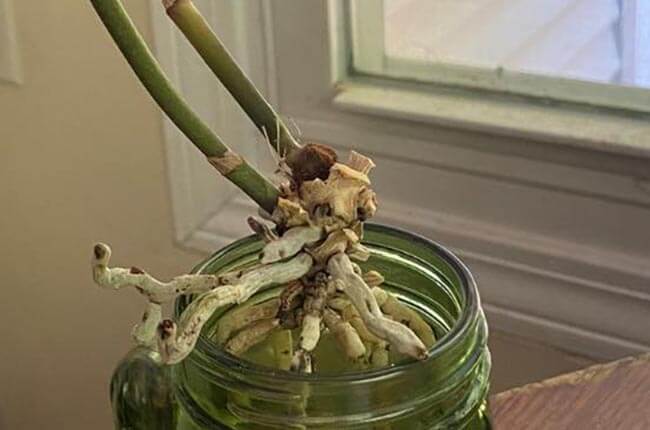An orchid without leaves is not necessarily a lost case.
Leafless orchids with a good stem and some root(s) can be rescued, especially with proper care and patience. To find the right remedy, you must first identify the cause according to its early symptoms. So, why does an orchid lose its leaves?
The common reasons for orchids losing leaves include overwatering, inappropriate watering techniques, problems in fertilizing, sunburn, extreme temperatures, dehydration, fungal and bacterial infections. These problems manifest in similar symptoms such as yellowing or browning of leaves and rotten roots.
But the remedy can be very different so it is crucial to find out the reasons in order to make the right diagnosis.
In this comprehensive article, we will go through these 8 possible causes, identify the early symptoms using pictures and the corresponding remedies to help you troubleshoot the problems of a sick orchid.
Let’s begin.
Can an orchid with no leaves survive?
First, it is important to check if the sick orchid has any sign at all to be rescued. It depends on the damage. For an orchid to survive without leaves, it must have at least one or some good root(s) and a good stem (the core).
- To know whether a stem is still viable, you can feel it and see if it is shriveled and dry. You may have to peel off some dried sheath around the stem to check the status of the inner core. You can even cut it open a little with sterilized cutters to see if there is some healthy green in the core. If the core is dry and brown, it is beyond rescue because the roots would not be able to send energy up the stem to grow new leaves.
- At least one or some healthy roots are also crucial for the orchid to regenerate its leaves. This is because the roots of epiphytic orchids can absorb water as well as conducting photosynthesis to produce food for the plant. If it is both leafless and rootless, the orchid is unfortunately dead.

Why is my orchid losing leaves? (Symptoms & Solutions)
There are 8 possible reasons for an orchid to lose its leaves:
1. Root rot due to overwatering, poor medium
Early symptoms: At the beginning, the leaves look dehydrated, and limp with a leathery texture. They would then worsen, become yellow and eventually fall off. New growths are small. Apart from dry leaves, there should also be rotten roots.
Root rot, rather than dehydration, can be confirmed when the leaves continue to appear dehydrated after watering.
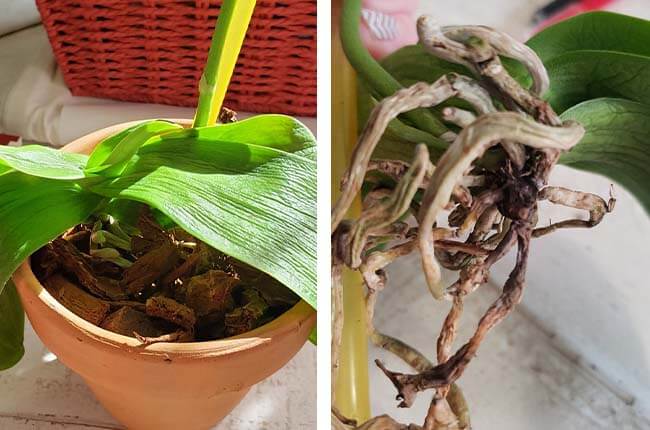
Cause: Overwatering is a major culprit for root rot for epiphytic orchids, whose natural habitat is growing above ground with their aerial roots receiving much airflow. Too much water reduces the air pockets in the medium for the roots, which often ends up suffocating the roots and causing root rot. A poor medium that is old, decomposed, and compacted will also lead to root rot.
Rotten roots would not be able to absorb water and would thus cause dehydration to the plant, causing leaves to shrivel, yellow, and eventually fall off.
Remedy and Prevention: To treat root rot, the orchid should be taken out of its old medium to remove the brown, mushy, rotten parts using sterilized tools.
The rotten covering of the roots can often be slipped off easily, leaving behind a string-like pith. These “stringy roots” are no longer efficient in absorbing water. Although they can still serve as stabilizing the plant in the new medium, they should be cut off especially if they are not completely clean with pieces of decomposed lumps remaining.
Spray the affected parts using a fungicide such as Physan 20. Let dry. Repot in fresh medium or suspend over water in a glass.
Check out this article for the different setups in caring for an orchid with root rot.
For prevention, the habit of overwatering should be eliminated. And the orchid should be repotted before the medium breaks down. Depending on the quality of the potting medium, a bark and moss medium typically lasts only 1-2 years, maximum 3 years.
2. Overhead watering resulting in Stem Rot / Crown Rot
Early Symptoms: An early symptom of stem rot is that one or several leaves become yellow at the base close to the stem. This should be differentiated from natural dieback or yellowing of leaves starting at the leaf tips (due to nutrient deficiency).
Part of the stem also looks brown and even shriveled if it is an advanced case.

Cause: Stem rot or crown rot is due to an inappropriate watering technique, such as watering from above or misting, which can cause water to be trapped in the crown or in the joints of the leaves. The top of the leaves, called “the crown”, is a very sensitive area that can easily get fungal infection and rot when it is in touch with standing water for a long time.
The infection in the crown, if untreated, would stop new leaves from growing, spread to the stem and then down to the roots, resulting in root rot also.
Stem rot or crown rot affects mainly monopodial orchids, like Phalaenopsis and Vanda, which grow leaves from one central, vertical stem with leaves growing on both sides.
Remedy and Prevention: Since crown rot is due to fungal infection, an effective remedy for crown rot is to use a fungicide such as Physan 20.
Keep the infected area dry by dusting over some cinnamon powder which serves as a natural fungicide.
Repot the orchid in a new medium of your choice. Keep the flower spikes, if any, but remove the flowers to prevent draining the energy of the plant. Flower spikes are kept to allow for keikis to grow which could often be in the base or in the flower spikes.
For prevention, eliminate the habit of overhead watering and dry off any water standing on the leaves. Move the orchid to a well-ventilated environment.
Related: Cause and treatment of stem rot
3. Problem with fertilizer
Early symptoms: Brown or very dark-colored patches in the roots. In a serious case, the roots would rot.

Cause: When a high concentration of fertilizer is used, mineral salts can be too strong for the orchid causing the root burn. Sensitive or unusual species of orchids are exceptionally susceptible to get root burn. Using hard water, e.g. tap water especially in hard-water areas can also aggravate the problem.
Remedy and Prevention: For a not very serious case of root burn, flush the orchid for 1 minute or soak it in a larger container for 15 minutes with rainwater or distilled water. Then dump the water. Repeat 2 more times.
For more serious cases of root burn where there is root rot, the orchid needs to be repotted in fresh medium and have the rotten parts removed.
For prevention, lower the strength of the fertilizer by feeding the orchid half or even a quarter of the recommended strength at each watering instead of a strong dose at periodic feeding. Use distilled water or rainwater for watering. In hard-water areas especially, pots should be flushed at least once a month to flush the salts.
Related: Proper way to fertilize your orchids
4. Sunburn and heat damage
Early symptoms: At the beginning, the leaves have discolored or yellow patches. The burn can range from superficial to total, which would cause the orchid to lose all its leaves. Sunburn can take weeks to show.
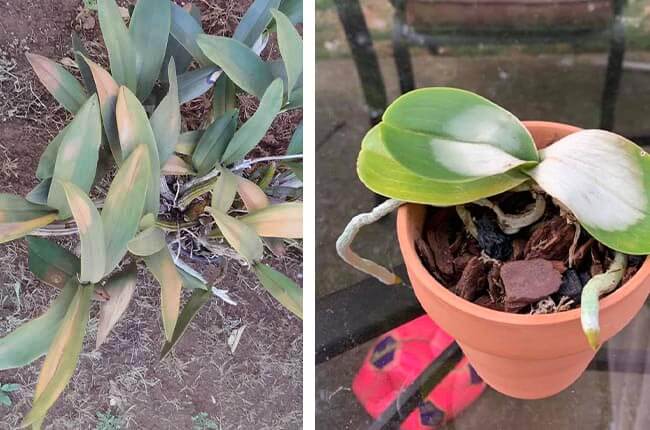
Cause: It is easy for orchids to get sunburned when they are moved from the indoors to the outdoors. Orchids whose natural habit is under a tree canopy in a forest do not like direct sun. The sun burnt areas will worsen as tissues die, making them more vulnerable to fungal and bacterial infection.
Remedy and Prevention: Cut away only the part of the leaf with sunburn or heat damage using sterilized cutters. Seal off the edges using cinnamon.
To recover, remove the burnt orchid(s) away from the direct sun and move it to a cooler and shadier location. If the orchid has flowers, they need to be removed to reduce stress and focus on recovery.
For prevention, grow indoor orchids by an east-facing window to receive the mild morning sunlight, rather than a south-facing window. To move an indoor orchid outdoors, it needs to be acclimatized by slowly increasing its exposure to light over a few weeks.
Related: Light requirement of different orchid species
5. Cold damage
Early symptoms: The leaves with cold damage would turn into yellow and brown patches a few days after the cold snap. The dead tissues would become mushy and worsen, leading to an eventual fall of the leaves.
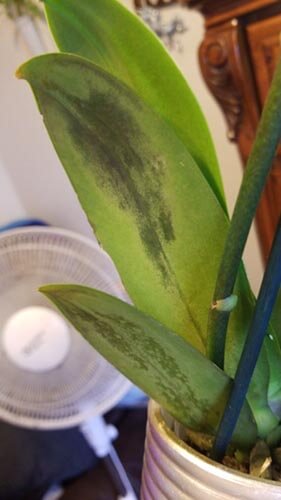
Cause: Orchids like to grow in a range of temperatures between 50 and 80 F. When they are exposed to temperatures outside their comfortable range for a period of time, they will show signs of temperature stress.
Remedy and Prevention: Cut only the part of the leaf with cold damage with sterilized cutters. Seal off the edges using cinnamon. Check the temperature of the environment. Pay attention to the temperature in the room that should not be below 50 degrees Fahrenheit (or 10 degrees Celcius).
6. Dehydration
Symptoms: Both the leaves and roots look dry and shriveled up and also feel papery. Some dehydrated leaves would also split.

Cause: A dehydrated orchid is often left bone dry for too many days due to neglect. Not enough water is given for the needs of the orchid.
Remedy and Prevention: Soon after it is well watered, a dehydrated orchid would recover.
The best way to prevent dehydration is to give your orchid more attention. Water it when the medium is dry.
7. Trimming the roots
Symptoms: Similar to the case of root rot, the leaves would look dry and dehydrated and the roots will start to become mushy and rotten.
Cause: Some people like to trim the roots because the aerial roots outside the pot are too long, get out of control, and do not fit the pot. But, when you cut a fresh tissue, you create an open wound, making it vulnerable to fungal or bacterial infection.
Apart from that, without enough roots, the orchid will also have a water absorption problem, leading to problems in photosynthesis. Cutting the tip of a root can make the whole root die off, leading to root rot.
Remedy and Prevention: Similar to the treatment for root rot, remove all the rotten parts and debris from the old medium. Clean well with water, disinfect using a fungicide such as Physan 20 and dust with cinnamon. Repot in a new medium.
To prevent this problem is to refrain from trimming the healthy roots of an orchid.
8. Fungal and bacterial infection
Symptoms: At the early stage there is a brown, black patch or water-soaked appearance on the leaves, often surrounded by yellow halos. The affected area often appears as random black patches on the leaves, which is different from the black rot caused by nutrient deficiency which manifests as a pattern.
If left unattended, the infection will quickly spread to the whole leaf and the roots and the leaves will fall off prematurely.
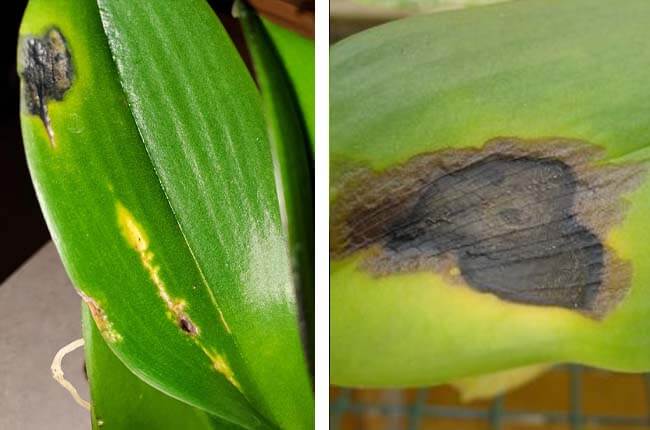
Cause: This is due to water standing on the leaves for a long time, promoting fungal and bacterial infection by some water-borne pathogens. This happens often when the temperature is low with high humidity and there is not enough air circulation for water to evaporate.
Remedy and Prevention: Use sterilized cutters to immediately remove the leaves with brown patches and throw them away. Clean the wounds using a fungicide such as Physan 20 and dust with cinnamon. Eliminate overhead watering and increase air circulation.
To prevent this from happening, avoid overhead watering and dry up any water left standing on the leaves. Make sure the growing environment is well-ventilated.
When and how will a leafless orchid grow back?
An orchid without leaves for photosynthesis is definitely going to have a setback in its growth. Fortunately, the remaining root(s) which has/have chlorophyll will be able to perform a little bit of photosynthesis to sustain the plant.
Depending on the extent of damage and the care provided, it can take a while between 2 weeks to 3 months to start seeing a small new growth. So, please be patient. 🙂
The new growth will be a keiki (orchid baby with its own roots and leaves) which could grow at the base of the stem or on a flower spike.
If you need a bit of motivation, watch this video to see how a leafless orchid is revived and grows keikis:
Conclusion
The major threat for an orchid’s health are overwatering, inappropriate watering technique, incorrect dosage of fertilizers, sunburn, extreme temperatures, dehydration, fungal and bacterial infections. Some of these problems will immediately lead to leaf rot and leaf fall, while others will end up in leaf fall only if the problem is left to worsen, leading to leaf infection and rotting.
With proper care and patience, an orchid without leaves is not doomed to die especially when it still has a good stem and some roots.
Although it can take a while to recuperate, the joy of rescuing a sick orchid is enormous and you will be rewarded by its long-lasting, beautiful blooms.
Happy growing!
Related
Orchid Stem Rot: Cause & Treatment You Should Know
Should I Soak My Orchids? (How To Do It Properly)
How Much Light Do Orchids Need? (with Light Chart)
Source
Sue Bottom. Orchid Pests and Diseases Diagnosis, Treatment and Prevention
- Top 6 Drip Irrigation Systems for Raised Beds (2025) - January 31, 2025
- Top 10 Orchid Fertilizers: A Comprehensive Review (2025) - January 16, 2025
- Top 6 Slow-Release Fertilizers for Houseplants & Veggies (2025) - January 15, 2025

